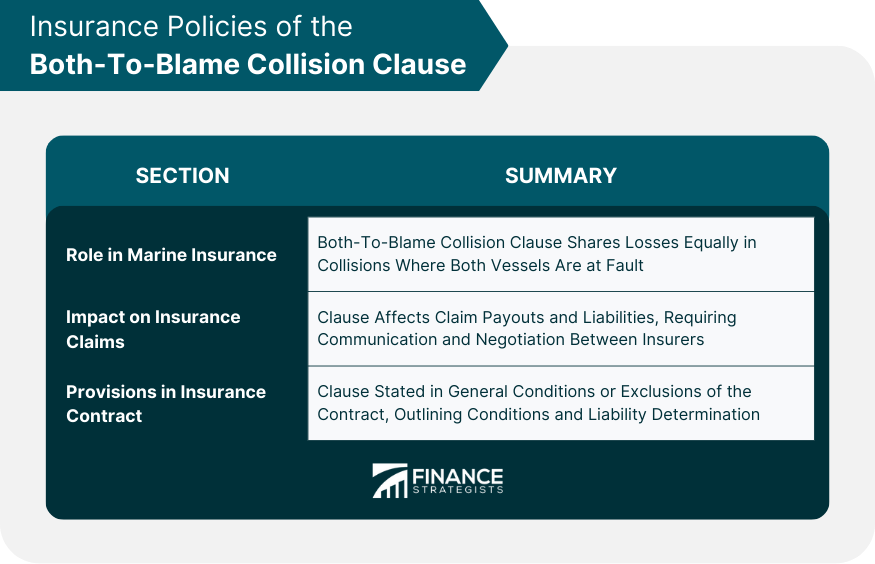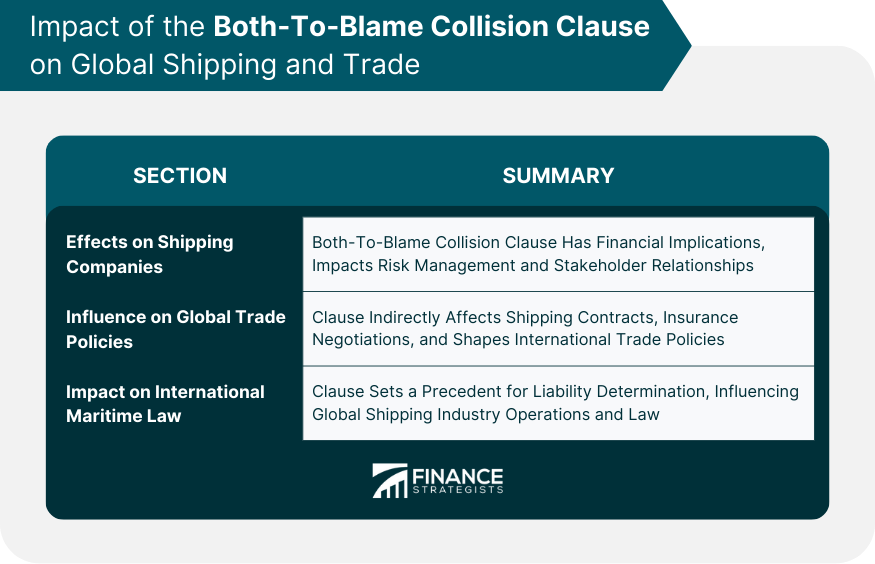The Both-To-Blame Collision Clause is a significant provision in maritime law stipulating that if two vessels are involved in a collision and both are at fault, the damages will be divided equally, irrespective of the degree of each party's fault. The clause's purpose is to distribute financial responsibility in the event of a collision, influencing behaviors on the high seas and the drafting of shipping contracts. Originating in the early 20th century, this clause emerged in response to the increase in vessel accidents due to expanding global trade. Rooted in the principle of 'general average,' which dictates that all loss is shared among all parties involved, the Both-To-Blame Collision Clause has evolved over time through a series of legal decisions and controversies, forming a critical part of today's maritime law. The Both-To-Blame Collision Clause serves a critical role in the shipping industry. It's often integrated into shipping contracts such as bills of lading and charter parties. Although its application can differ between jurisdictions, the clause's primary aim remains consistent: to evenly distribute financial liability when a collision occurs between two at-fault vessels. This principle serves as a fundamental guide in managing risks and obligations within the global maritime sector. The Both-To-Blame Collision Clause is a composite of several key elements, the first being the determination of fault. Once fault is determined to lie with both parties, the financial responsibility for losses is divided equally, regardless of the degree of fault. The inclusion of the Both-To-Blame Collision Clause in shipping contracts has far-reaching implications, altering the potential legal and financial outcomes of a collision. It shifts the potential financial burden in a way that can significantly influence the behaviors and attitudes of ship operators. Historically, there have been numerous instances of the clause's implementation. One notable example was the collision between the vessels "Vessel A" and "Vessel B" in 1983, which resulted in significant financial implications due to the equal division of the multimillion-dollar damages. In marine insurance, the Both-To-Blame Collision Clause has a distinct role. Insurers often incorporate the clause into their policies, reinforcing the principle that losses should be shared equally in the event of a collision where both vessels are at fault. The clause can significantly impact insurance claims, influencing the payout amounts and liabilities. It also complicates the claims process as both vessels' insurers must communicate and negotiate the claim's settlement. The Both-To-Blame Collision Clause is usually stipulated within the general conditions or exclusions of an insurance contract. The specific provisions can vary, but typically they outline the conditions under which the clause will be invoked and how liability will be determined. The Both-To-Blame Collision Clause is not without its critics. Among the concerns raised are issues of fairness, particularly in cases where one party is deemed minimally at fault. The clause can also create significant complexities and delays in resolving claims. The clause has sparked numerous legal debates over the years, focusing on its implications for fairness and justice. It has been challenged in several jurisdictions, resulting in varied interpretations and applications. From an ethical standpoint, the Both-To-Blame Collision Clause raises questions about the equitable distribution of loss. Critics argue that it unfairly penalizes those who are less at fault, while supporters argue it promotes caution and responsibility among all parties. For shipping companies, the Both-To-Blame Collision Clause has significant financial implications. It can also affect their risk management strategies and relationships with insurers and other stakeholders. The clause can impact global trade policies indirectly, influencing negotiations around shipping contracts and insurance. It plays a role in shaping the legal landscape of international maritime trade. As a part of international maritime law, the clause sets a precedent for handling ship collisions worldwide. It influences the way in which liability is determined and shared, which in turn affects the global shipping industry's operations. The future may bring changes to the Both-To-Blame Collision Clause as debates continue around its fairness and efficacy. Any amendments could significantly impact the shipping and insurance industries, affecting contracts, policies, and claims processes. As legal frameworks evolve, there may be innovations in the way the Both-To-Blame Collision Clause is applied. Developments in technology and data analysis could also influence its application, potentially enabling more precise determination of fault. Technological advancements in the shipping industry, such as automated vessels and advanced navigation systems, could influence the Both-To-Blame Collision Clause's future. These changes may necessitate revisions of the clause to reflect new operational realities. The Both-To-Blame Collision Clause plays a significant role in the shipping industry, globally influencing maritime law, insurance policies, and trade practices. This clause, grounded in the principle of 'general average,' ensures that financial responsibility in ship collisions is shared, driving caution among operators. However, it isn't without controversy, as it can complicate insurance claims resolution and potentially penalize parties minimally at fault unfairly. Nevertheless, this clause is essential in managing shipping industry risks. With evolving legal, technological, and operational landscapes, the clause's interpretation and application could be impacted, possibly necessitating revisions or adaptations. Ultimately, the clause symbolizes the complex interplay of safety, liability, and fairness in the risky world of shipping.Both-To-Blame Collision Clause Overview
Application in the Shipping Industry
Detailed Explanation of the Both-To-Blame Collision Clause
Elements of the Clause
Implications of the Clause on Contracts
Instances of Implementation
Both-To-Blame Collision Clause in Insurance Policies
Role in Marine Insurance
Impact on Insurance Claims
Provisions of the Clause in an Insurance Contract

Criticisms and Controversies of the Both-To-Blame Collision Clause
Discussion of Issues and Concerns
Legal Debates
Ethical Considerations
Impact of the Both-To-Blame Collision Clause on Global Shipping and Trade
Effects on Shipping Companies
Influence on Global Trade Policies
Impact on International Maritime Law

Future of the Both-To-Blame Collision Clause
Possible Changes and Their Implications
Innovations in Legal Frameworks and Contracts
Impact of Technological Advancements in the Shipping Industry
Bottom Line
Both-to-Blame Collision Clause FAQs
The Both-To-Blame Collision Clause is a provision in maritime law that states if two vessels are involved in a collision, and both are found to be at fault, the damages will be split equally between them, regardless of the degree of each party's fault.
In marine insurance, the Both-To-Blame Collision Clause often impacts the payout amounts and liabilities in the event of a collision. It complicates the claims process as insurers for both vessels need to negotiate the settlement of the claim.
Critics of the Both-To-Blame Collision Clause argue that it can unfairly penalize the party that is less at fault in a collision. It has also been criticized for creating complexities and potential delays in resolving insurance claims.
The Both-To-Blame Collision Clause can influence the negotiations around shipping contracts and insurance, shaping the legal landscape of international maritime trade. It also has financial implications for shipping companies, affecting their risk management strategies.
Possible future changes to the Both-To-Blame Collision Clause might come as a result of ongoing debates about its fairness and efficacy. Technological advancements in the shipping industry could also necessitate modifications to the clause to reflect new operational realities.
True Tamplin is a published author, public speaker, CEO of UpDigital, and founder of Finance Strategists.
True is a Certified Educator in Personal Finance (CEPF®), author of The Handy Financial Ratios Guide, a member of the Society for Advancing Business Editing and Writing, contributes to his financial education site, Finance Strategists, and has spoken to various financial communities such as the CFA Institute, as well as university students like his Alma mater, Biola University, where he received a bachelor of science in business and data analytics.
To learn more about True, visit his personal website or view his author profiles on Amazon, Nasdaq and Forbes.













